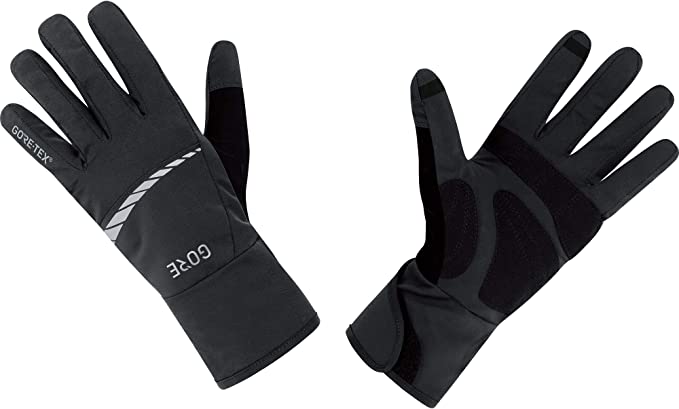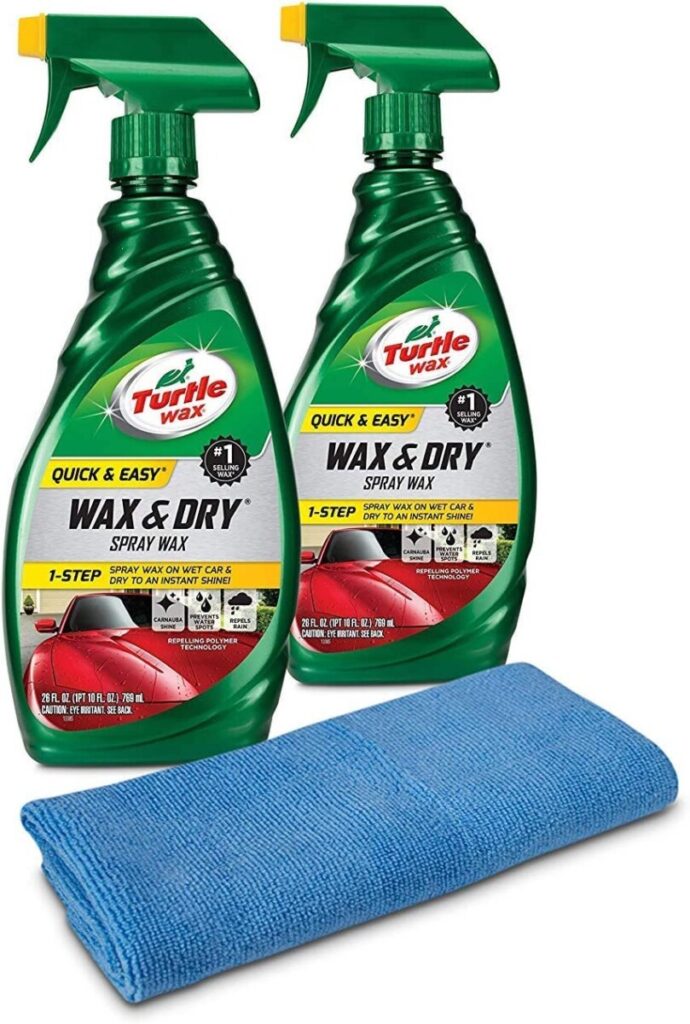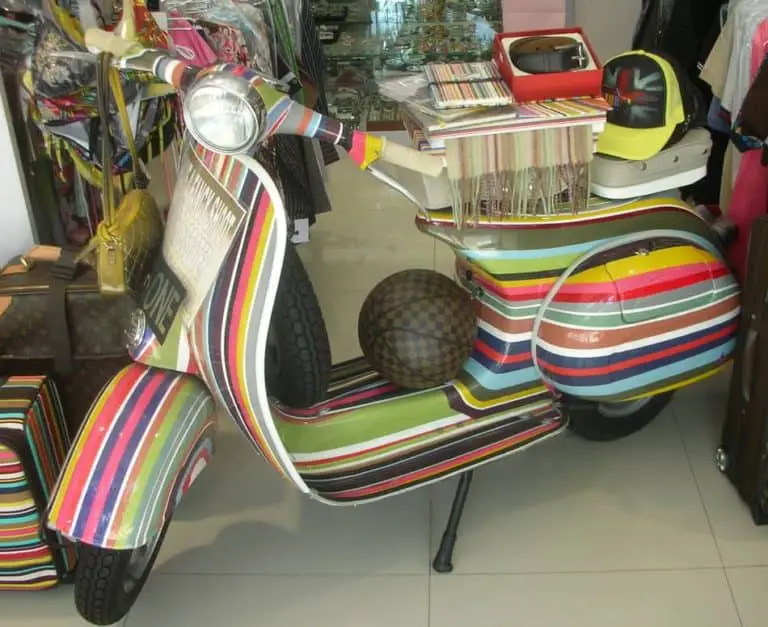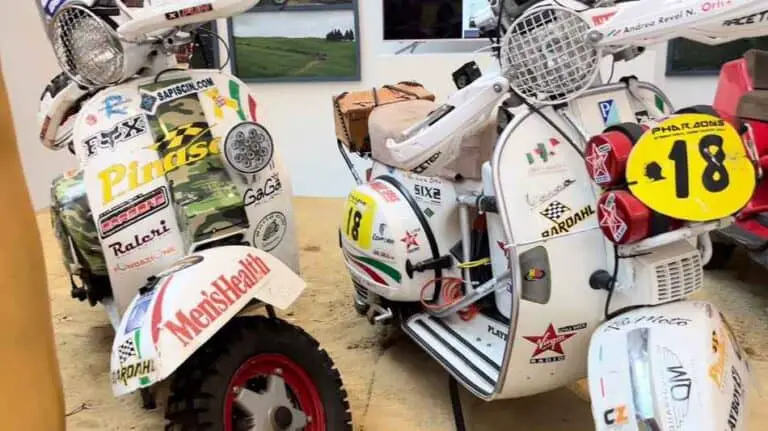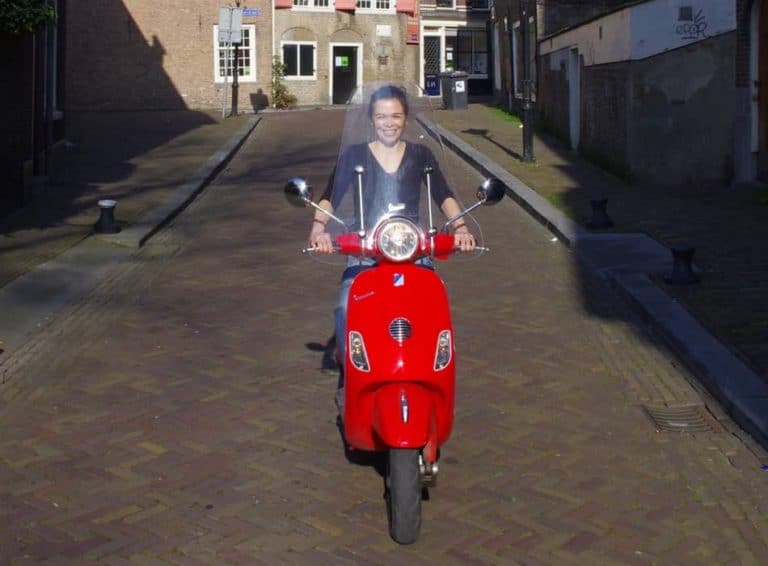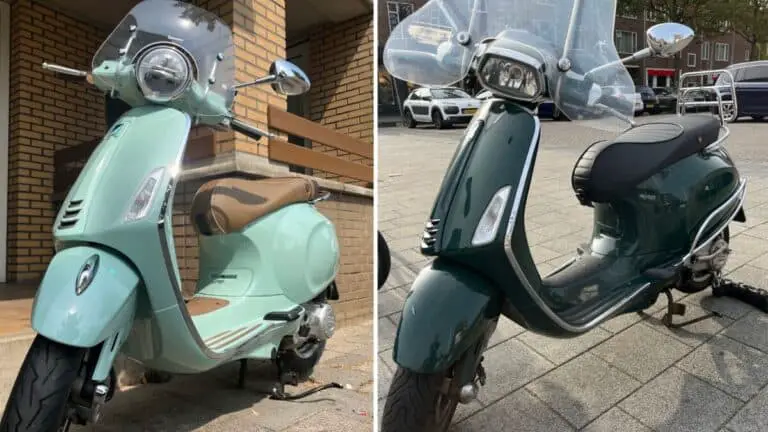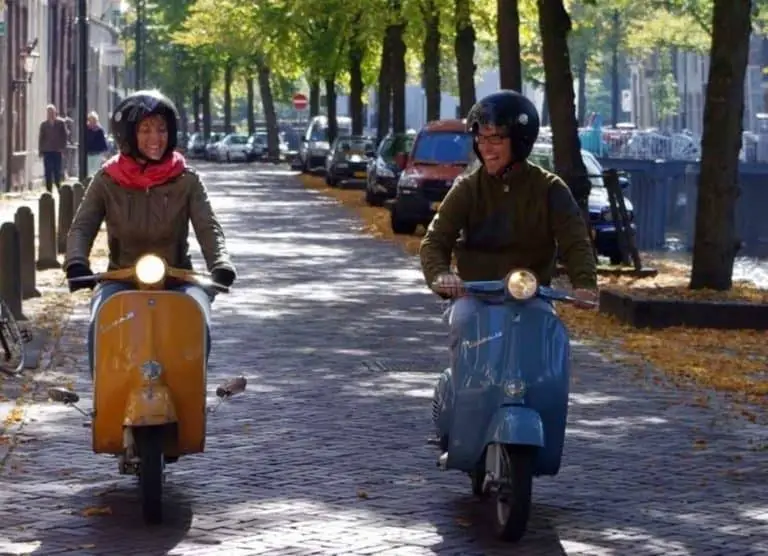Can You Ride Your Vespa In The Rain? Beware Of These Precautions
While we prefer to only drive a Vespa on a nice sunny summer day, you can’t avoid riding your Vespa in the rain. In this case, driving conditions are different and it could be even more dangerous if proper precautions are not taken.
From our own experience, we know that slippery roads and reduced visibility can make driving in the rain more challenging.
A Vespa is designed with safety and comfort in mind so rain will not affect the scooter itself. However extra precautions are needed to increase your safety. Ensure to weatherproof your Vespa, wear appropriate gear, maintain safe speeds, and handle slippery roads with care when driving in the rain.
While Vespa scooters can handle most weather conditions, it is best to put safety first when deciding whether or not to ride in harsh weather. We don’t drive in heavy rain, snow, or on gusty days with high winds at all.
If you must ride your Vespa in these conditions, then besides the extra precautions the level of driving experience should be taken into consideration as well.
Which precautions do you need to take when driving your Vespa in the rain?
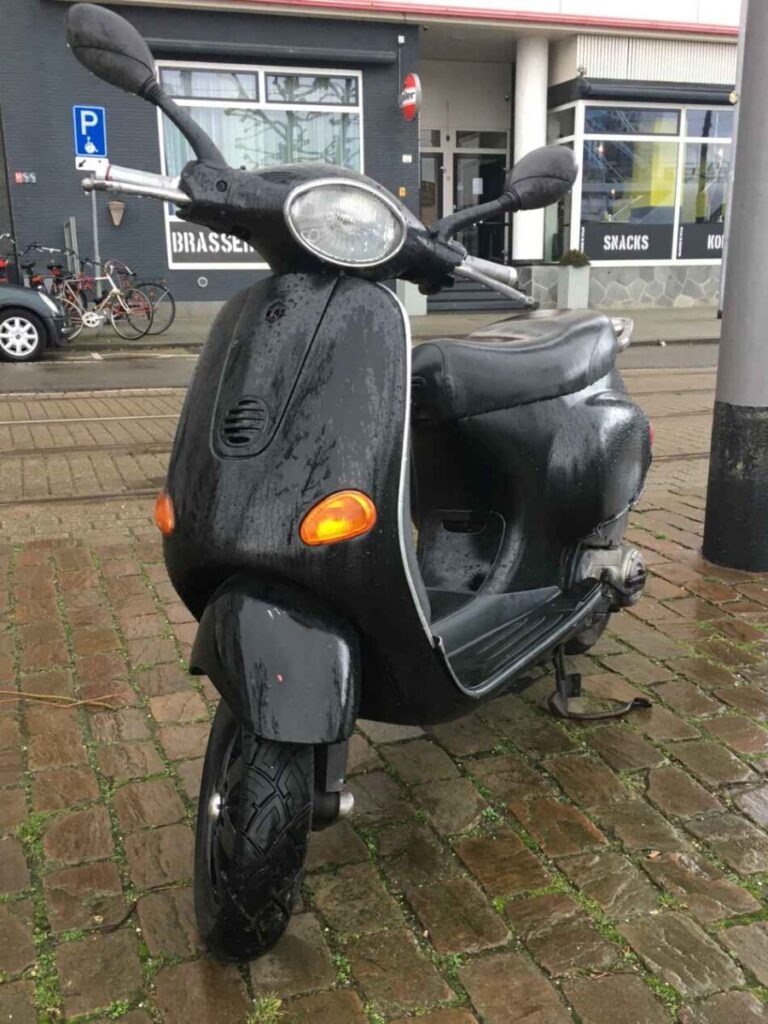
1. Slow Down and Brake Gently
The road can get slippery in wet conditions. The wet surface reduces tire traction, making it harder to control the scooter. So when riding a Vespa in the rain, it’s best to drive slowly and avoid sudden movements or sharp turns that could cause skidding or hydroplaning.
Hydroplaning occurs when water accumulates between the tires of your vehicle and the road surface, causing them to lose contact with each other. As a result, you can lose control over your vehicle.
Remember that braking hard on a slippery road can cause the wheels to lock up and slide out from under you. Instead, apply the brakes gradually and gently while slowing down.
Driving experience is the most important for driving safely in the rain
2. Maintain distance
Make sure you maintain a safe distance from other vehicles on the road. The stopping distance of a Vespa increases significantly in wet conditions, so keeping a safe distance will give you more time to react if necessary.
Wet brakes are another issue that can affect your Vespa’s performance in rainy conditions. Water on the brake pads or discs reduces their effectiveness, which means you’ll need to brake earlier and more gently than usual when riding in the rain.
3. Reduced Visibility
One major challenge of riding a Vespa in heavy rain is reduced visibility. Raindrops on your helmet visor or glasses can blur your vision, making it difficult to see other vehicles and obstacles on the road.
To improve your visibility in the rain, you should invest in a good quality full-faced helmet with an anti-fog visor. If you don’t want to replace your existing helmet then you can place this anti-fog film on your visor.
A clear shield or visor will also provide better visibility than tinted ones during low-light conditions caused by heavy rainfall.
Many Vespas also come with a windscreen. This also prevents getting too much rain on your face when driving. However, make sure you go for a good-quality windscreen. When we were driving in the rain just before it got dark, we could hardly see a thing when an approaching vehicle drove towards us with its lights on.
Besides being able to see traffic properly, you have to make sure you are seen as well by others. When purchasing a proper raincoat or waterproof jacket try to make sure it has reflectors as well. Other drivers will be able to see you much better in dark rainy conditions.
4. Be aware of different road conditions
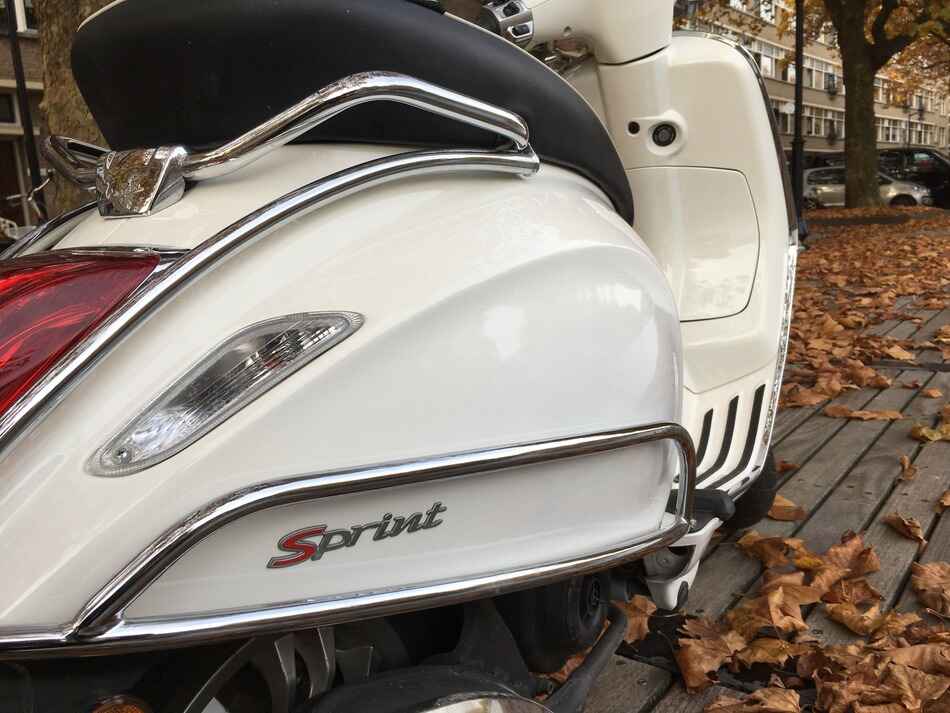
Intersections, puddles, and wet leaves can be slippery and cause accidents when riding a Vespa in the rain. It’s essential to be extra cautious when approaching these areas by slowing down and taking extra care. Wet leaves on the road surface are especially dangerous as they can reduce traction significantly.
Puddles and standing water can be deceiving as they may hide potholes, rocks, or other hazards that could cause accidents. To avoid such risks, try to ride around them if possible. If you cannot avoid them, slow down and proceed with caution. Be aware of the depth of the water and the condition of the road beneath it.
5. Check Tires condition
Before heading out on a rainy day, it is essential to check your Vespa tires’ tread depth and tire pressure. Good traction is necessary when riding on wet roads to prevent skidding or slipping.
It is therefore also important that your tires are in good condition when driving in wet conditions. Worn or underinflated tires will result in less traction on wet roads, making it more difficult to control your Vespa.
Are you unsure what the correct tire pressure is for your Vespa model? We have listed the tire pressure of the most common Vespas in the article about tires.
6. Consider Installing a Windshield
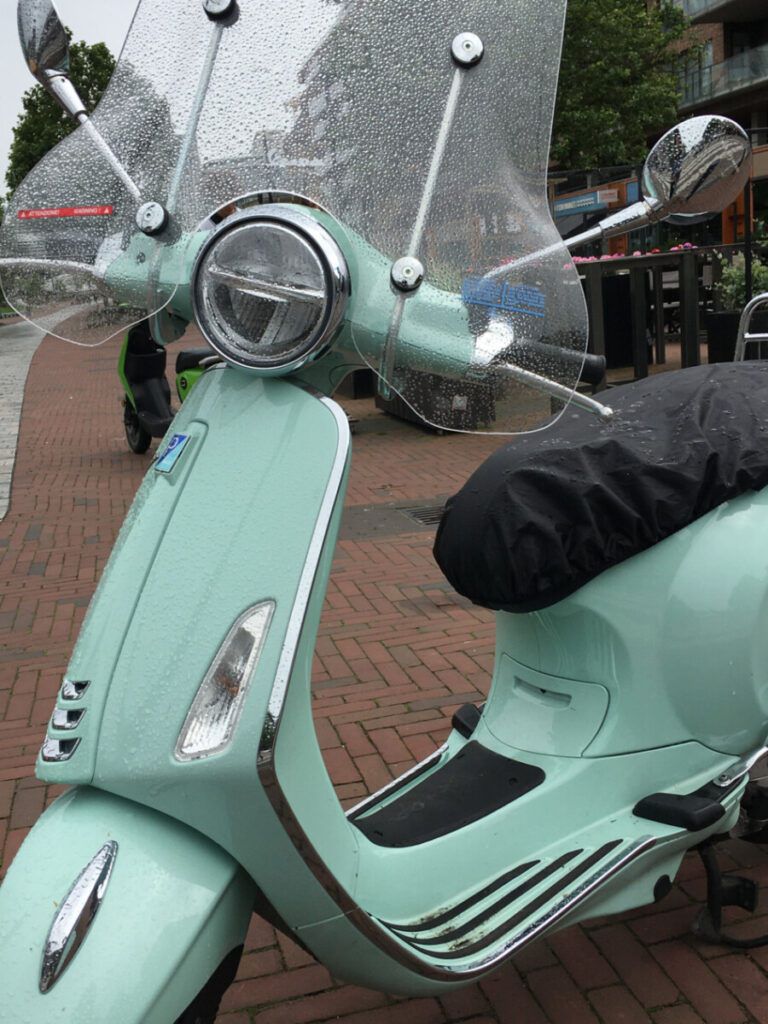
Finally, if you ride your Vespa frequently in wet weather conditions, consider installing a windshield. This can shield you from rain and wind while riding, making your journey more comfortable and safe.
Windshields are available in various sizes and designs to fit different models of Vespas. They are typically made of high-quality materials such as polycarbonate or acrylic that provide the clarity you need when driving in the rain.
What gear should I wear when riding my Vespa in the rain?
Wearing appropriate gear increases your driving comfort which enables you to drive more safely in the rain. So make sure you invest in proper gear such as waterproof jackets and pants, especially if you use your Vespa on a daily basis and hit the highway often.
Wet clothes can make you feel cold and uncomfortable, which can be distracting and affect your focus on the road. Additionally, wet clothes can lead to hypothermia if you are exposed to low temperatures for an extended period.
Waterproof jacket
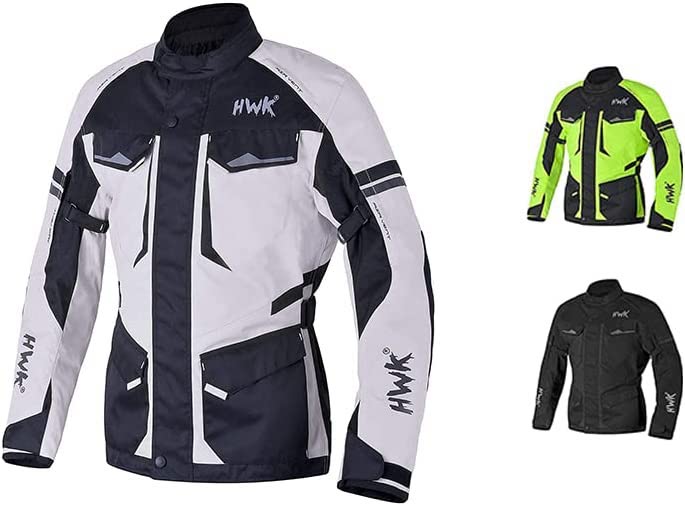
One of the most important pieces of gear you’ll need is a waterproof jacket. This will help keep you dry and comfortable throughout your ride. But not all jackets are created equal, so it’s important to choose one that’s specifically designed for wet weather.
Look for jackets with sealed seams to prevent water from seeping in. These seams are specially designed to keep moisture out, even during heavy rainstorms. Consider investing in gear specifically designed for motorcyclists. Motorcycle gear is made with durable materials that can withstand the elements and provide added protection against wind and rain.
While staying dry is important when riding in the rain, you also want to make sure you’re comfortable throughout your journey. To achieve this goal, opt for gear made from breathable materials that allow air flow while keeping water out.
Rain jackets made from Gore-Tex or similar materials are ideal because they’re both waterproof and breathable at the same time. This means you won’t get overheated or uncomfortable during your ride, even if it’s raining all day long.
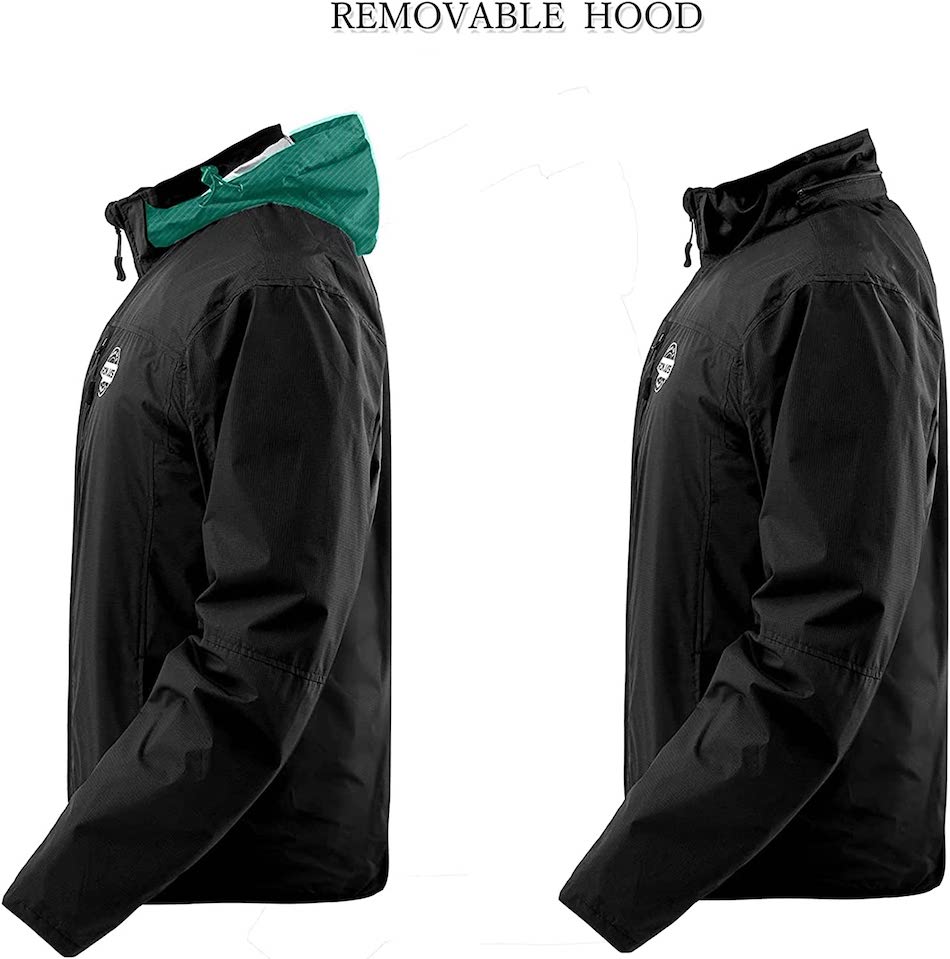
Pants and boots are also often included in proper motorcycle gear. However, for a Vespa, we think this isn’t entirely necessary. Of course, if you find it comfortable then we highly recommend going for waterproof pants and proper shoes. But due to the design of a Vespa, your legs will not get as wet as with a regular motorcycle.
We can imagine that those who mainly drive their Vespa in the city or for short distances want to keep their riding gear minimal. If this is the case for you, then you can consider adding a leg cover to your Vespa. Not only will it keep your legs and feet dry when driving in the rain, but it will keep you warm as well.
You can go for an original Vespa cover, such as the picture below, or go for a universal one, which you can find here.
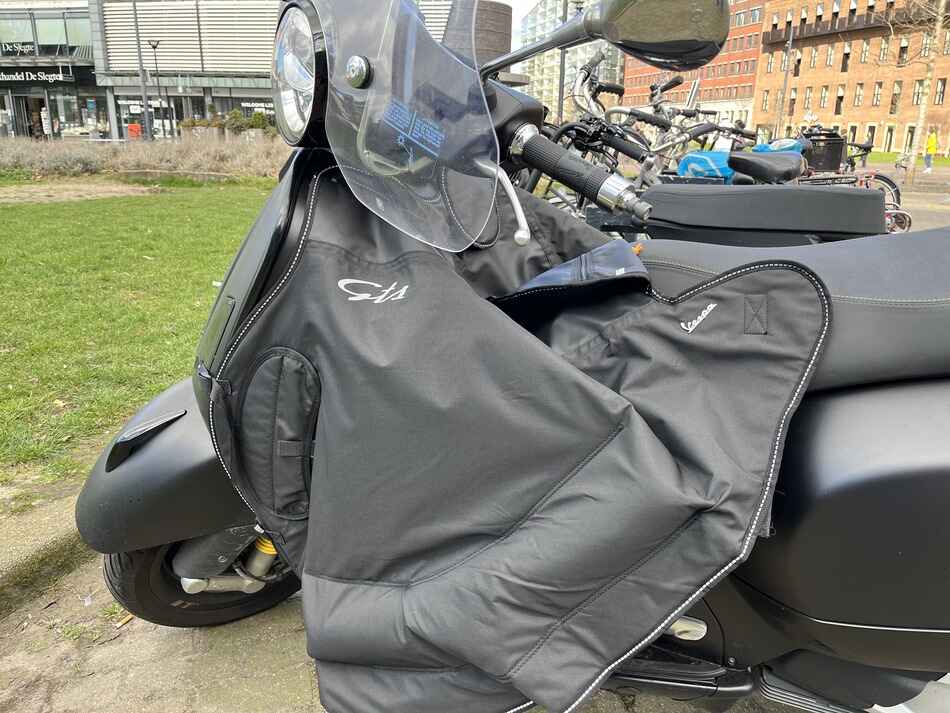
Proper Helmet
As mentioned earlier, visibility will decrease when driving in wet conditions. A full-face helmet with a visor will help avoid getting rain in your eyes. So besides full-face helmets being the safest option when choosing a helmet, it also makes driving in the rain more comfortable.
There are even helmets with a visor that can be adjusted for rainy conditions. Ideal for Vespa owners living in countries where it often rains, such as here in The Netherlands.
In an article on helmets, we wrote more about what to look out for when choosing the correct helmet when driving a Vespa.
Hand protection
Your hands are one of the most vulnerable parts of your body when riding in wet conditions. That’s why it’s essential to wear waterproof gloves that protect them from cold temperatures and moisture.
Look for gloves made from waterproof materials like neoprene or Gore-Tex that will keep your hands dry no matter how hard it rains outside. Consider wearing liners underneath your gloves to provide added insulation against the cold.
How do I protect my Vespa from the rain?
While a Vespa can handle rainy conditions, you can take extra measures to prevent the moisture from slowly damaging your scooter.
Use a Waterproof Cover
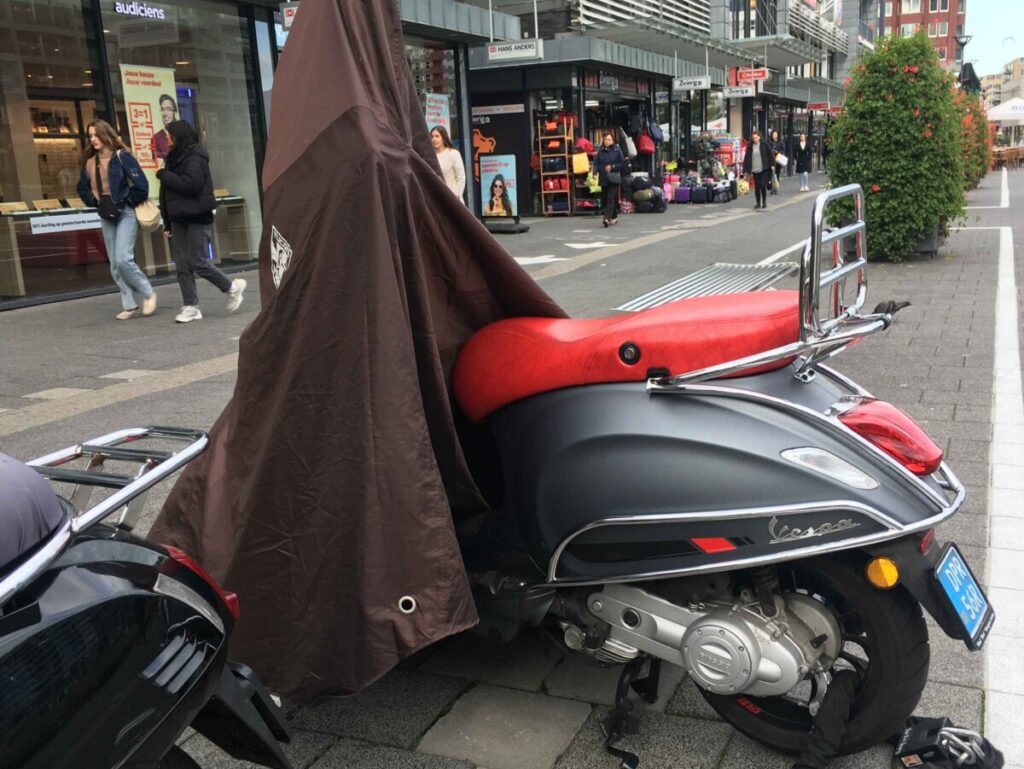
One of the easiest ways to protect your Vespa from rain is by using a waterproof cover. A good quality cover will provide excellent protection against rain, hail, and snow. It will also prevent dirt, dust, and debris from accumulating on your scooter while it’s parked.
Investing in a high-quality cover will keep your Vespa dry and prevent rust from forming on its metal parts.
When picking a cover for your Vespa, choose one made of strong materials like polyester or nylon. These materials are light and can handle bad weather. Make sure the cover has sturdy seams and elastic hems to keep it in place. Vespa has its own covers as well. You can check them out here.
It is however important that you dry your Vespa as soon as possible to prevent mold and moisture from building up once it is tucked away under the cover.
Install Waterproof Seat Covers
If you ride your Vespa regularly in wet weather conditions, then water can seep into the seat foam and cause damage over time. To avoid this problem, consider installing waterproof seat covers on your scooter.
Waterproof seat covers for Vespas come in different sizes and designs. They’re made of good materials like vinyl or neoprene that keep water away. You don’t need special tools or skills to put them on.
Apply wax
To further protect your Vespa from rain, you can apply turtle wax and spray to its exterior surfaces. This spray creates a barrier that prevents it from penetrating the paintwork or metal parts.
This spray is meant for cars but can of course be applied to your Vespa as well. The spray contains special additives that provide the best protection against rust and corrosion as well as water damage.
How do I maintain my Vespa after a rainy ride?
In addition to covering your Vespa, it’s also important to keep it clean and dry after a drive in the rain. A Vespa has a metal body making it very durable, however also prone to rust. Wiping down the seat and other exposed parts with a soft towel will prevent moisture buildup that could lead to mold growth or rust formation over time.
Areas, where the paintwork is somewhat damaged, are very sensitive to rust, so make sure you dry these areas thoroughly and consider applying additional wax or grease to prevent more rust from accumulating.
Additionally, rubber seals around the engine and electrical components of your Vespa play a critical role in keeping water out. Over time, these seals can become worn or damaged, allowing water to enter and cause damage.
To avoid this problem, it’s important to check all rubber seals on your Vespa regularly. If you notice any signs of wear or damage, replace them immediately with new ones. This will ensure that your Vespa stays dry even in the wettest weather conditions.



